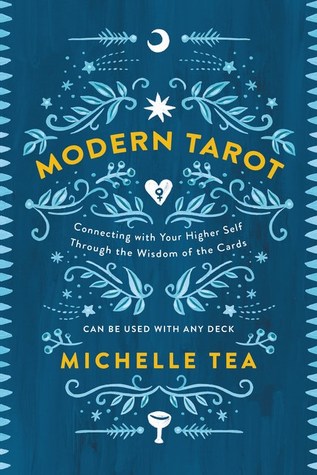by Michelle Tea

I wish that I’d had this book when I started reading tarot in the 90s, but as I realized from the anecdotes included throughout the book, that’s because Michelle Tea is in my age range and was learning all the stuff that’s in this book. So, I guess the takeaway is that this book exists NOW, and what a lucky thing for all the new readers getting started who get to use this book as one of their primary texts.
I was already familiar with Tea’s fiction and essays prior to picking up this book, and I wasn’t surprised that she chose to write a tarot book because tarot figures prominently in her body of writing. If you haven’t already read her creative work, and you enjoyed this book, then I’d say you’re probably in for a treat, because the same voice, feel, and themes are explored in both the creative and the tarot technique books.
A couple notes on some other the other critiques I’ve seen: Yes, there are a few language choices that could have been done better, and we can hope that perhaps future press runs will update those terms to have more inclusivity and more decolonized language. So for readers sensitive to this, just know that you may see the outdated term “spirit animal” in the book.
There were also some comments about how a lot of the suggested exercises after the cards that call for crystals, herbs, etc.: There is a note in the “How to Use This Book” introduction on pg 15 where the author clearly states that the suggested items are just that: *suggestions.* Not only is it specifically stated that the author tried to suggest easier to find, less-expensive items, but it is also stated that *you can substitute whatever you have handy, because it’s the intention that matters most.” — So on that critique, I think it’s a bit unfair to the author because none of the items are required, and the author specifically notes that coming from life experiences where she was broke AF, using whatever you have handy is totally ok.
What I loved about this book is that like 78 Degrees of Wisdom, it’s very “generational” in its approach to tarot, and on first read, it felt both timely and timeless. All the groundwork of how tarot has been read historically is there, but updated, tailored, and augmented for the modern world, modern readers, and a more intersectional approach to the cards. Where other tarot books might have a slightly “gatekeeper-y” feel to them, or a lofty approach that makes some readers feel left out of the conversation, this book is on the whole, welcoming and inviting to all. It’s great for readers at any level, because for new readers it’s a handy “everything you need to know” text, and for advanced readers, it’s a “here’s some things you might not have considered, that can shake up your reading routines.”
It’s especially welcoming to marginalized folx, who may feel left out by gendered keywords and binaries, that allows the same cards to be used, but with a modernized approach to how to read them. I appreciated this, because I think that everyone should be able to “see themselves” in the cards, even if the images on the cards remain largely unchanged.
I think one of the most unique parts of this book is the “action items” included at the end of each card chapter, for people who enjoy a little more ritual, or want to have more active engagement with the cards. While I am not personally of this demographic, I did enjoy reading the suggested rituals so that I can tailor them and scale them down to new ways to approach my own routines.
It’s a practical, fun, welcoming introduction (or expansion) to tarot knowledge and technique, written in a truly conversational way, with personal anecdotes that readers will be able to connect with because it’s taking a modern approach to old ideas and that, I think, is what will make this book remain a tarot library standard for generations to come.